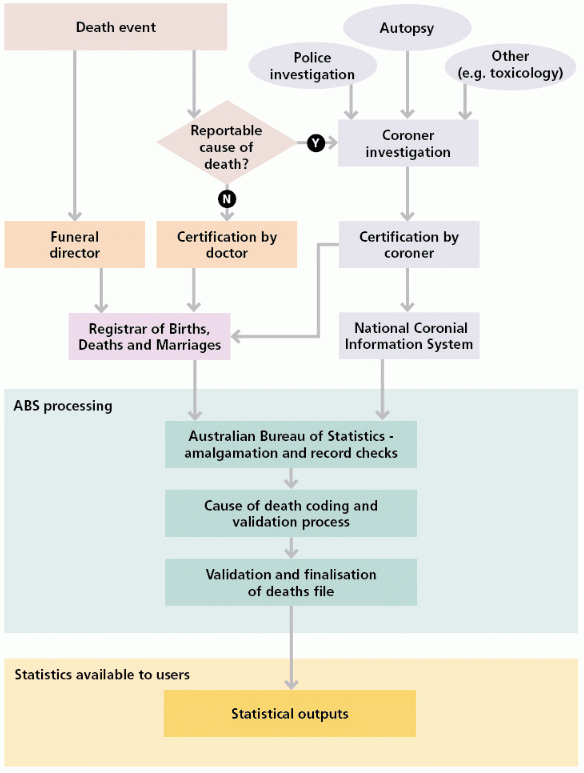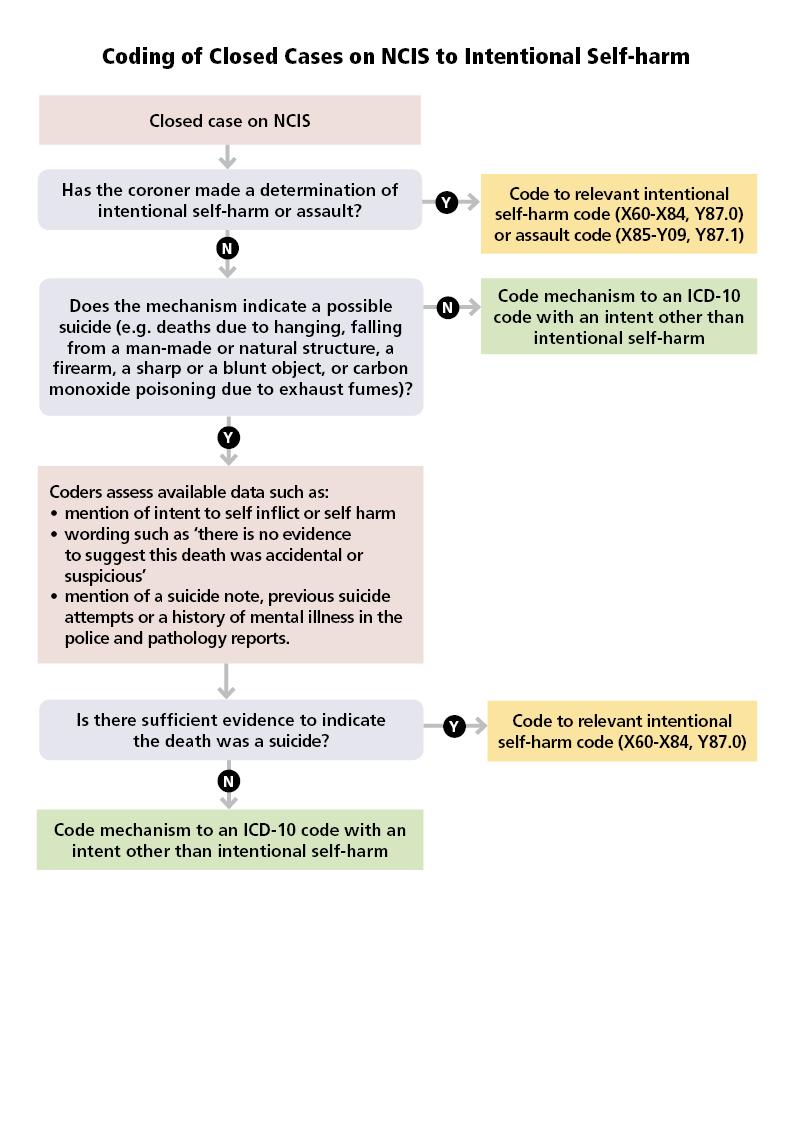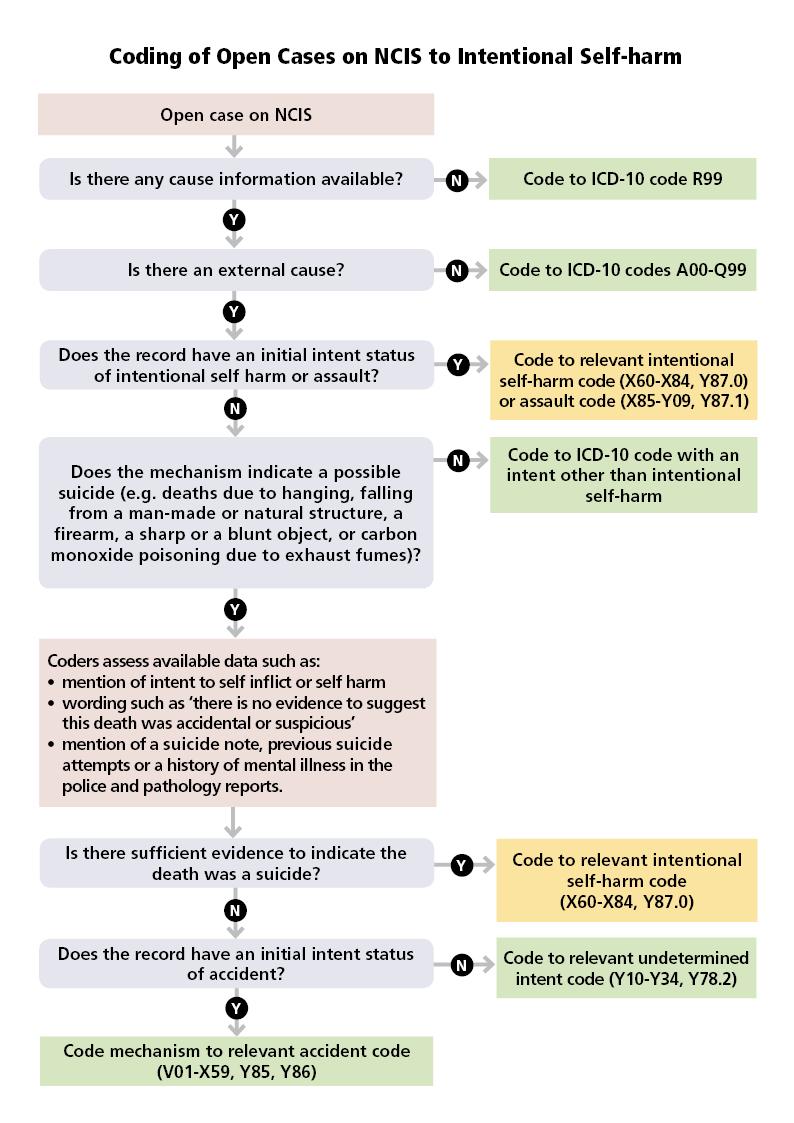Australian causes of death statistics
This publication contains statistics on causes of death for Australia, together with selected statistics on perinatal deaths.
To complete a death registration, the death must be certified by either a doctor using the Medical Certificate of Cause of Death, or by a coroner. In 2022, 87.8% of deaths were certified by a doctor. The remaining 12.2% were certified by a coroner. There are variations between jurisdictions in relation to the proportion of deaths certified by a coroner, ranging from 6.0% of deaths certified by a coroner and registered in Queensland, to 29.1% of deaths certified by a coroner and registered in the Northern Territory.
To complete a perinatal death registration, the death must be certified by either a doctor, using the Medical Certificate of Cause of Perinatal Death, or by a coroner. In 2022, 97.0% of perinatal deaths were certified by a doctor, with the remaining 3.0% certified by a coroner.
It is the role of the coroner to investigate the circumstances surrounding all reportable deaths and to establish, wherever possible, the circumstances surrounding the death, and the cause(s) of death. Although there is variation across jurisdictions in what constitutes a death that is reportable to a coroner, they are generally reported in circumstances such as:
- where the person died unexpectedly and the cause of death is unknown
- where the person died in a violent or unnatural manner
- where the person died during, or as a result of an anaesthetic
- where the person was 'held in care' or in custody immediately before they died
- where the identity of the person who has died is unknown.
The registration of deaths is the responsibility of the eight individual state and territory Registries of Births, Deaths and Marriages. As part of the registration process, information about the cause of death is supplied by the medical practitioner certifying the death or by a coroner. Other information about the deceased is supplied by a relative or other person acquainted with the deceased, or by an official of the institution where the death occurred. The information is provided to the Australian Bureau of Statistics (ABS) by individual registries for coding and compilation into aggregate statistics. In addition, the ABS supplements this data with information from the National Coronial Information System (NCIS). As a voluntary collaboration between the Australian States and Territories and New Zealand, the NCIS is independent of the coronial system and does not form any part of the coronial investigation process. The NCIS enables access to some documents from the coronial investigation, however it is not intended to be a full replica of the coronial brief.
The diagram below outlines the Australian Causes of Death Statistics System. Each death is certified by either a doctor or coroner and the resultant information is provided to the Australian Bureau of Statistics (ABS) through the Registrar of Births, Deaths and Marriages in each state or territory. Information is also provided via the National Coronial Information System for those deaths certified by a coroner. The ABS processes, codes and validates this information, which is then provided in statistical outputs.
Australian causes of death statistics system
Image

Description
Scope of causes of death statistics
The ABS Causes of Death collection includes all deaths that occurred and were registered in Australia, including deaths of persons whose usual residence was overseas. Deaths of Australian residents that occurred outside Australia may be registered by individual registries but are not included in ABS deaths or causes of death statistics.
The current scope of the statistics includes:
- all deaths being registered for the first time
- deaths in Australia of temporary visitors to Australia
- deaths occurring within Australian Territorial waters
- deaths occurring in Australian Antarctic Territories or other external territories (including Norfolk Island)
- deaths occurring in transit (i.e. on ships or planes) if registered in the Australian state or territory of 'next port of call'
- deaths of Australian Nationals overseas who were employed at Australian legations and consular offices (i.e. deaths of Australian diplomats while overseas) where able to be identified
- deaths that occurred in earlier reference periods that have not been previously registered (late registrations).
The scope of the statistics excludes:
- repatriation of human remains where the death occurred overseas
- deaths of foreign diplomatic staff in Australia (where these can be identified)
- stillbirths/fetal deaths (these are included in perinatal death statistics (see Perinatal deaths)). In 2007-2009 these were published separately in Perinatal Deaths, Australia, 2009 (cat. no. 3304.0) but are now included in this publication.
Deaths registered on Norfolk Island from 1 July 2016 are included in this publication. This is due to the introduction of the Norfolk Island Legislation Amendment Act 2015. Norfolk Island deaths are included in statistics for "Other Territories" as well as totals for all of Australia. Deaths registered on Norfolk Island prior to 1 July 2016 were not in scope for death statistics. Prior to 1 July 2016, deaths of people that occurred in Australia with a usual residence of Norfolk Island were included in Australian totals but assigned a usual residence of 'overseas'. With the inclusion of Norfolk Island as a territory of Australia in the Australian Statistical Geography Standard (ASGS) 2016, those deaths which occurred in Australia between January and June 2016 with a usual residence of Norfolk Island were allocated to the Norfolk Island SA2 code instead of the 'overseas' category.
Presentation of mortality data
Ideally, for compiling annual time series, the number of deaths should be recorded and reported as those which occurred within a given reference period, such as a calendar year. In Australia, a death cannot be registered until a burial or cremation has occurred. This requirement can result in delays in the registration of deaths and not all deaths are registered in the year that they occur. There may also be further delays to the ABS receiving notification of the death from the registries due to processing or data transfer lags. Therefore, every death record will have:
- a date on which the death occurred (the date of occurrence)
- a date on which the death is registered with the state and territory registry (date of registration)
- a date on which the registered death is lodged with the ABS and deemed in scope (reference date).
Data can be presented in different ways based on these dates.
Year of registration
For the 2022 Causes of Death publication data is presented by year of registration (based on date of registration). This represents a change from previous years where data was presented by reference year. This change has been applied across all years to enable consistency of time series for comparable analysis. For some years, the number of deaths registered in that year is the same as the number that fall within scope of the reference year, but for other years, the numbers are quite different.
In recent years, there have been occasions where the ABS has received a large number of deaths which were registered in earlier years. These death registrations fell within scope of the reference year in which they were received. Therefore presenting deaths data by reference year is not necessarily representative of mortality patterns in that year and can have a greater impact on specific causes of death. For examples of where the ABS has received late registrations and the impact on mortality patterns, see Technical Note: Victorian additional registrations and time series adjustment and Technical Note: Victorian additional registrations (2013-2016).
Reference year
Prior to 2022, Causes of Death data was presented by reference year (based on reference date). The scope for reference year includes:
- deaths registered in the reference year and received by the ABS in the reference year
- deaths registered in the reference year and received by the ABS in the first quarter of the subsequent year
- deaths registered in the years prior to the reference year but not received by ABS until the reference year or the first quarter of the subsequent year, provided that these records have not been included in any statistics from earlier periods.
Data for the ABS Deaths, Australia publication will continue to be presented by reference year. Therefore total numbers of deaths for each year in the Causes of Death publication will not necessarily match total numbers of deaths in the Deaths publication. The table below shows the differences in numbers over the last 10 years.
| Reference year (Deaths) | Registration year (Causes of Death) | Difference(a) | |
|---|---|---|---|
| 2022 | 190,939 | 190,939 | 0 |
| 2021 | 171,469 | 171,469 | 0 |
| 2020 | 161,300 | 161,300 | 0 |
| 2019 | 169,301 | 166,560 | -2,741 |
| 2018 | 158,493 | 160,097 | 1,604 |
| 2017 | 160,909 | 162,044 | 1,135 |
| 2016 | 158,504 | 159,174 | 670 |
| 2015 | 159,052 | 159,170 | 118 |
| 2014 | 153,580 | 154,040 | 460 |
| 2013 | 147,678 | 148,265 | 587 |
- Reference year data includes a large number of deaths received by the ABS for registrations in earlier years. This resulted in larger differences between reference and registration numbers in those years. Refer to the Data Quality section for more details.
Year of occurrence
Data can also be presented by year of occurrence (based on date of occurrence). Approximately 5% to 8% of deaths occurring in one year are not registered until the following year or later.
A small number of tables in the Causes of Death publication are published by year of occurrence, ie. Table 11.21 in the '11. Intentional self-harm (suicide)' data cube; all tables in the '14. Causes of Death by year of occurrence' data cube; and Table 15.25 in the '15. Perinatal deaths' data cube.
Information in the Causes of Death and Deaths publications is not comparable with deaths data published in the monthly Provisional Mortality Statistics reports which provides preliminary counts of deaths by date of occurrence.
Causes of Death data by reference year or year of occurrence is available on request.
Acknowledgements
This publication draws extensively on information provided freely by the state and territory Registries of Births, Deaths and Marriages, and the Victorian Department of Justice who manage the National Coronial Information System (NCIS). Their continued cooperation is very much appreciated: without it, the wide range of vital statistics published by the ABS would not be available. Additionally, the ABS would like to acknowledge assistance provided by the Coroners Court of New South Wales. Information received by the ABS is treated in strict confidence as required by the Census and Statistics Act 1905.

